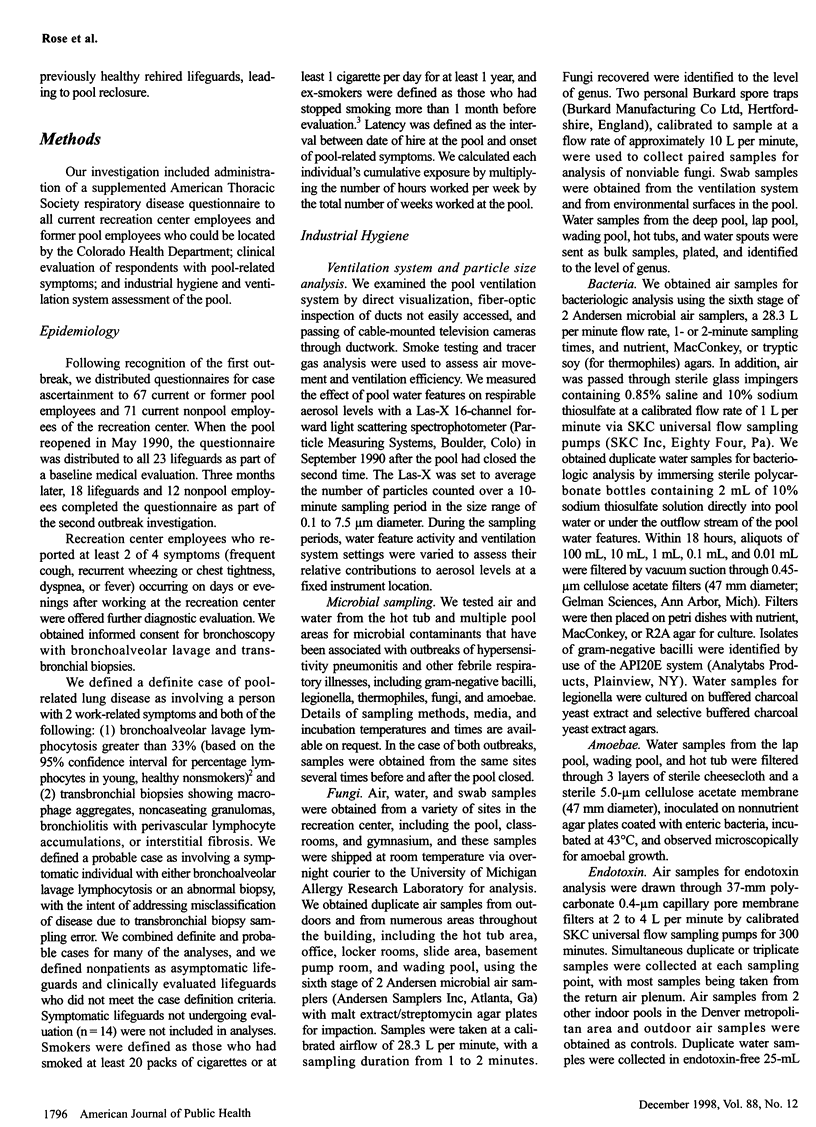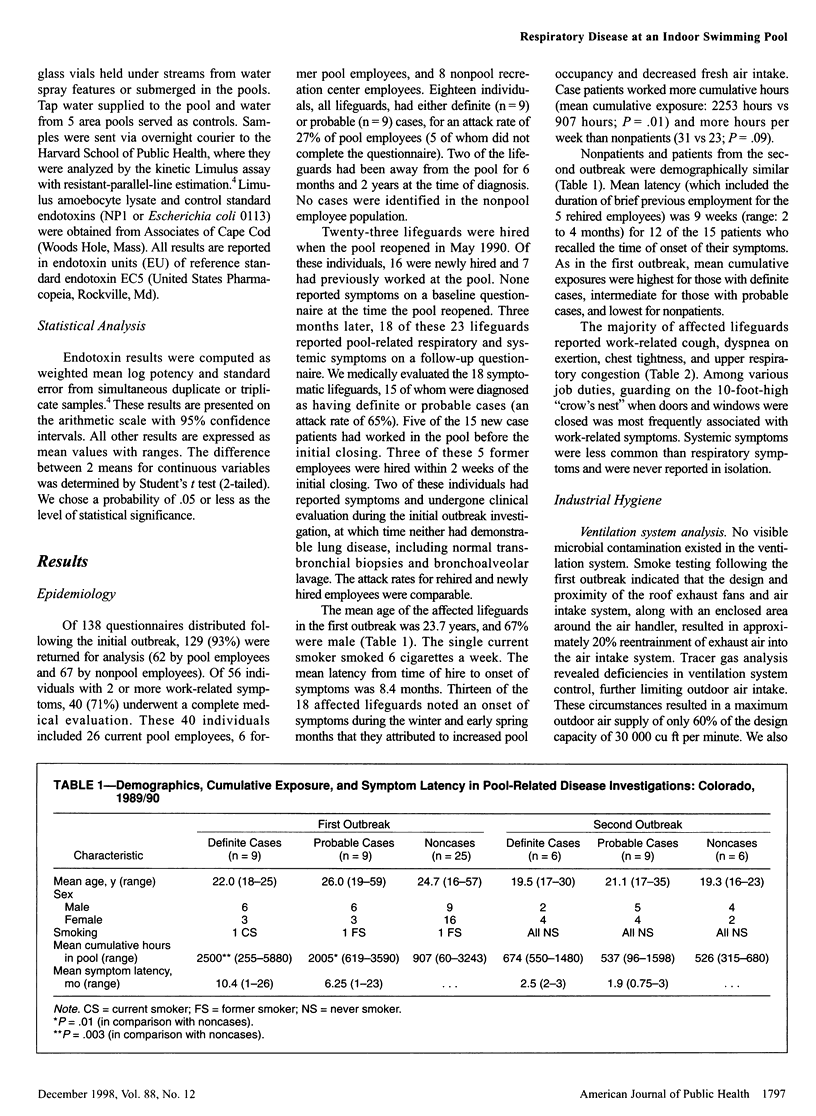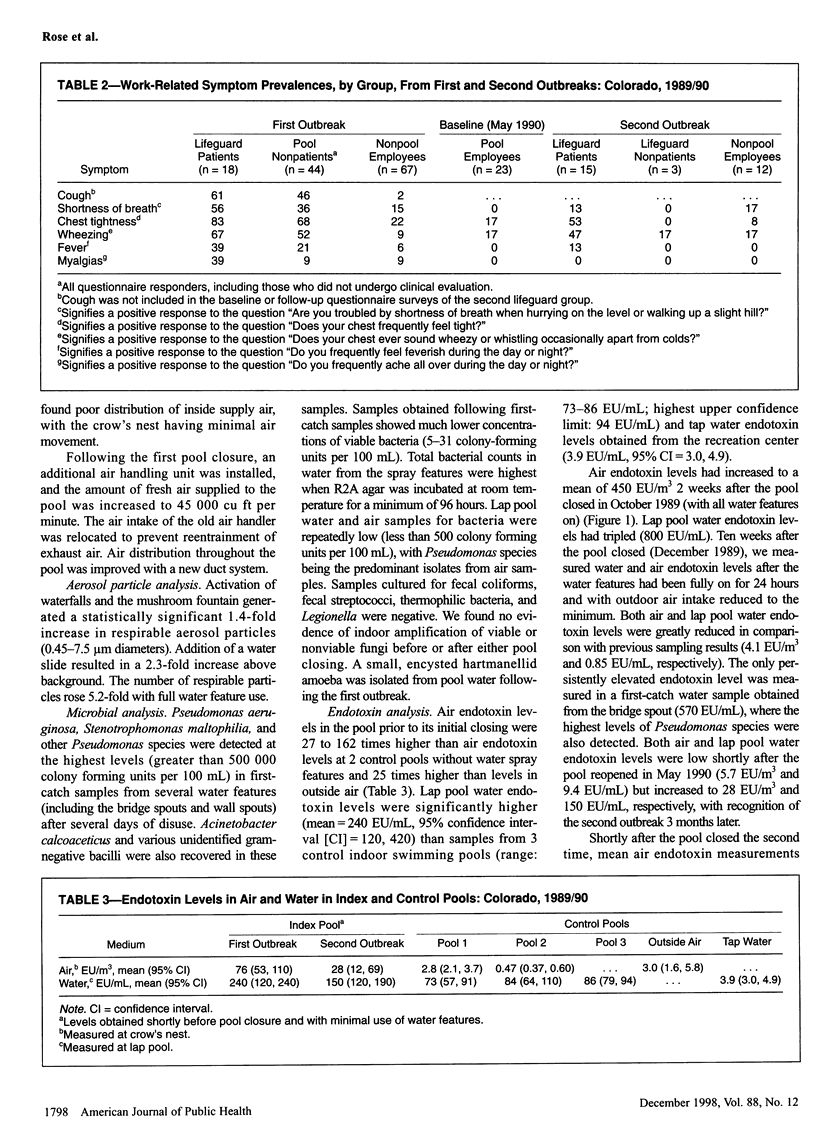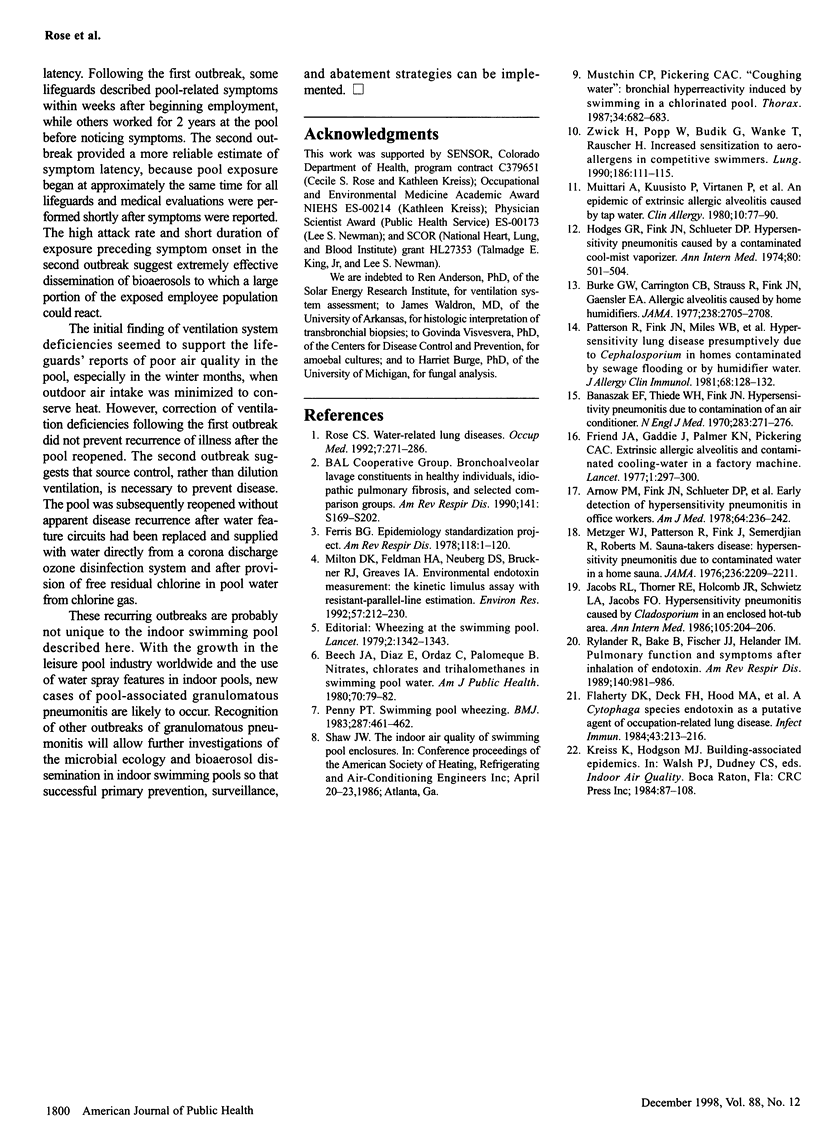Abstract
OBJECTIVES: Two sequential outbreaks of respiratory disease among lifeguards at an indoor swimming pool with water spray features were investigated. METHODS: Questionnaires were administered to recreation center employees following each outbreak. Respondents reporting 2 or more pool-related symptoms were offered clinical evaluation, including bronchoscopy with bronchoalveolar lavage and transbronchial biopsy. Pool air and water were sampled for fungi, bacteria, amoebae, endotoxin, and respirable particulates. RESULTS: Thirty-three lifeguards had noncaseating granulomas on biopsy and/or bronchoalveolar lavage lymphocytosis. Attack rates for the outbreaks were 27% and 65%. Case patients had higher cumulative hours of work and tended to work more hours per week. Analyses indicated increased levels of endotoxin in pool air and water (relative to control pools) and gram-negative bacterial colonization of water sprays. Use of water spray features generated a 5.2-fold increase in the number of respirable particles and up to an 8-fold increase in air endotoxin levels. CONCLUSIONS: Lifeguards in this indoor swimming pool developed granulomatous lung disease associated with endotoxin-containing respirable bioaerosols from water spray features, which ventilation system improvements did not prevent.
Full text
PDF





Selected References
These references are in PubMed. This may not be the complete list of references from this article.
- Arnow P. M., Fink J. N., Schlueter D. P., Barboriak J. J., Mallison G., Said S. I., Martin S., Unger G. F., Scanlon G. T., Kurup V. P. Early detection of hypersensitivity pneumonitis in office workers. Am J Med. 1978 Feb;64(2):236–242. doi: 10.1016/0002-9343(78)90051-7. [DOI] [PubMed] [Google Scholar]
- Banaszak E. F., Thiede W. H., Fink J. N. Hypersensitivity pneumonitis due to contamination of an air conditioner. N Engl J Med. 1970 Aug 6;283(6):271–276. doi: 10.1056/NEJM197008062830601. [DOI] [PubMed] [Google Scholar]
- Beech J. A., Diaz R., Ordaz C., Palomeque B. Nitrates, chlorates and trihalomethanes in swimming pool water. Am J Public Health. 1980 Jan;70(1):79–82. doi: 10.2105/ajph.70.1.79. [DOI] [PMC free article] [PubMed] [Google Scholar]
- Burke G. W., Carrington C. B., Strauss R., Fink J. N., Gaensler E. A. Allergic alveolitis caused by home humidifiers. Unusual clinical features and electron microscopic findings. JAMA. 1977 Dec 19;238(25):2705–2708. [PubMed] [Google Scholar]
- Ferris B. G. Epidemiology Standardization Project (American Thoracic Society). Am Rev Respir Dis. 1978 Dec;118(6 Pt 2):1–120. [PubMed] [Google Scholar]
- Flaherty D. K., Deck F. H., Hood M. A., Liebert C., Singleton F., Winzenburger P., Bishop K., Smith L. R., Bynum L. M., Witmer W. B. A Cytophaga species endotoxin as a putative agent of occupation-related lung disease. Infect Immun. 1984 Jan;43(1):213–216. doi: 10.1128/iai.43.1.213-216.1984. [DOI] [PMC free article] [PubMed] [Google Scholar]
- Friend J. A., Gaddie J., Palmer K. N., Pickering C. A., Pepys J. Extrinsic allergic alveolitis and contaminated cooling-water in a factory machine. Lancet. 1977 Feb 5;1(8006):297–300. doi: 10.1016/s0140-6736(77)91839-6. [DOI] [PubMed] [Google Scholar]
- Hodges G. R., Fink J. N., Schlueter D. P. Hypersensitivity pneumonitis caused by a contaminated cool-mist vaporizer. Ann Intern Med. 1974 Apr;80(4):501–504. doi: 10.7326/0003-4819-80-4-501. [DOI] [PubMed] [Google Scholar]
- Jacobs R. L., Thorner R. E., Holcomb J. R., Schwietz L. A., Jacobs F. O. Hypersensitivity pneumonitis caused by Cladosporium in an enclosed hot-tub area. Ann Intern Med. 1986 Aug;105(2):204–206. doi: 10.7326/0003-4819-105-2-204. [DOI] [PubMed] [Google Scholar]
- Metzger W. J., Patterson R., Fink J., Semerdjian R., Roberts M. Sauna-takers disease. Hypersensitivity pneumonitis due to contaminated water in a home sauna. JAMA. 1976 Nov 8;236(19):2209–2211. doi: 10.1001/jama.236.19.2209. [DOI] [PubMed] [Google Scholar]
- Milton D. K., Feldman H. A., Neuberg D. S., Bruckner R. J., Greaves I. A. Environmental endotoxin measurement: the Kinetic Limulus Assay with Resistant-parallel-line Estimation. Environ Res. 1992 Apr;57(2):212–230. doi: 10.1016/s0013-9351(05)80081-7. [DOI] [PubMed] [Google Scholar]
- Muittari A., Kuusisto P., Virtanen P., Sovijärvi A., Grönroos P., Harmoinen A., Antila P., Kellomäki L. An epidemic of extrinsic allergic alveolitis caused by tap water. Clin Allergy. 1980 Jan;10(1):77–90. doi: 10.1111/j.1365-2222.1980.tb02083.x. [DOI] [PubMed] [Google Scholar]
- Mustchin C. P., Pickering C. A. "Coughing water": bronchial hyperreactivity induced by swimming in a chlorinated pool. Thorax. 1979 Oct;34(5):682–683. doi: 10.1136/thx.34.5.682. [DOI] [PMC free article] [PubMed] [Google Scholar]
- Penny P. T. Swimming pool wheezing. Br Med J (Clin Res Ed) 1983 Aug 13;287(6390):461–462. doi: 10.1136/bmj.287.6390.461. [DOI] [PMC free article] [PubMed] [Google Scholar]
- Rose C. S. Water-related lung diseases. Occup Med. 1992 Apr-Jun;7(2):271–286. [PubMed] [Google Scholar]
- Rylander R., Bake B., Fischer J. J., Helander I. M. Pulmonary function and symptoms after inhalation of endotoxin. Am Rev Respir Dis. 1989 Oct;140(4):981–986. doi: 10.1164/ajrccm/140.4.981. [DOI] [PubMed] [Google Scholar]
- Zwick H., Popp W., Budik G., Wanke T., Rauscher H. Increased sensitization to aeroallergens in competitive swimmers. Lung. 1990;168(2):111–115. doi: 10.1007/BF02719681. [DOI] [PubMed] [Google Scholar]


